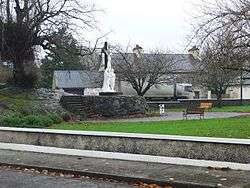Tuamgraney
| Tuamgraney An Tuaim Gréine | |
|---|---|
| Village | |
|
Tuamgraney Garden of Remembrance | |
 Tuamgraney Location in Ireland | |
| Coordinates: 52°54′00″N 8°32′00″W / 52.9000°N 8.5333°WCoordinates: 52°54′00″N 8°32′00″W / 52.9000°N 8.5333°W | |
| Country | Ireland |
| Province | Munster |
| County | County Clare |
| Time zone | WET (UTC+0) |
| • Summer (DST) | IST (WEST) (UTC-1) |
| Irish Grid Reference | R639845 |
Tuamgraney (or Tomgraney; Irish: Tuaim Gréine, meaning "Tomb of Gráinne") is a village in eastern County Clare in the west of Ireland and a civil parish by the same name. Situated a kilometere from the River Graney which flows into Lough Derg, it is an ancient settlement, noted for St Cronán's Church, said to be the oldest church in constant use in Ireland or the United Kingdom.[1]
Location
The parish is in the barony of Tulla Upper and contains the villages of Scarriff and Tomgraney. It is 7.5 by 2.75 miles (12.07 by 4.43 km) and covers 14,181 acres (5,739 ha). The parish is rugged, with heights ranging from 1,126 to 122 feet (343 to 37 m) above sea level. It contains the Scariff river from its headstreams through Lough O'Grady to its mouth in Scarriff bay, Lough Derg.[2] The village of Tuamgraney lies in such close proximity to the town of Scarriff that today the two are often considered to be one single settlement.[3] There is a holy well dedicated to St. Cronán in the Currakyle townland.[4] The nearby castle of Tuamgraney is still in a good state of preservation.[5]
History
Tuamgraney parish was founded by a saint named Cronán or Chronain, possibly the same Crónán Abbot and bishop who founded Roscrea. The place is mentioned in the annals from as early as 735 AD. There was a round tower, which was repaired by Brian Boru, and the castles of Tuamgraney and Scarriff. In 1560 both castles belonged to Edmond O'Grady.[4]
In 1633 Richard Boyle, 1st Earl of Cork, bought ten quarters of land north of the Graney River, including the castle and ironworks of Scarriff. These lands were combined with the old Moynoe parish to form the Scariff parish.[5] Today the village of Scarriff is in the Roman Catholic parish of Scariff and Moynoe, part of the Roman Catholic Diocese of Killaloe.[6] The southern part of Tuamgraney parish was combined with the medieval parish of Kilnoe early in the 18th century to form the parish of Bodyke.[7] The Roman Catholic parish of Bodyke encompasses Bodyke, Kilnoe and Tuamgraney, also in the Killaloe Diocese.[8]
The Ó Cillín family were coarbs of
The novelist Edna O'Brien was born in Tuamgraney in 1930. Noted genealogist Edward MacLysaght is buried at St. Cronan's Church.[9]
Annalistic references
See Annals of Inisfallen (AI)
- AI749 Kl. Death of Conchellach, abbot of Tuaim Gréine.
- AI934.1 Kl. Repose of Rebachán son of Mothla, abbot of Tuaim Gréine and king of Dál Cais.
- AI1003.8 Repose of Donngal son of Beoán, abbot of Tuaim Gréine.
- AI1020.2 Muiredach Ua hAililléin, lector of Tuaim Gréine, rested in Christ.
- AI1024.8 Niall Ua Cellaig, lector of Tuaim Gréine, rested in Christ.
- AI1026.7 Conall Ua Cillíne, coarb of Crónán of Tuaim Gréine, fell asleep.
See also
References
- ↑ http://www.irishtimes.com/culture/through-the-door-of-history-1.306374
- ↑ "Tomgraney, or Tomgreni". Parliamentary Gazeteer of Ireland. 1845. Retrieved 2014-04-02.
- ↑ Guide To Lough Derg and the Shannon Region: Scariff and Tuamgraney
- 1 2 Lewis, Samuel (1837). County Clare, A History and Topography. Ennis: CLASP Press. p. 125ff. ISBN 1-900545-00-4. Retrieved 2014-03-30.
- 1 2 "A History of Tuamgraney and Scariff since Earliest Times". East Clare Heritage. Retrieved 2014-03-30.
- ↑ "Scariff and Moynoe". Diocese of Killaloe. Retrieved 2014-04-02.
- ↑ "Bodyke (Lúbán Díge)". County Clare Library. Retrieved 11 September 2013.
- ↑ "Bodyke (Kilnoe and Tuamgraney)". Diocese of Killaloe. Retrieved 2014-03-30.
- ↑ http://www.irishtimes.com/culture/through-the-door-of-history-1.306374

